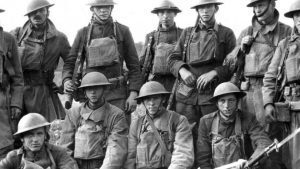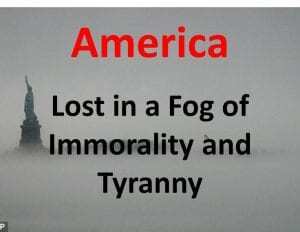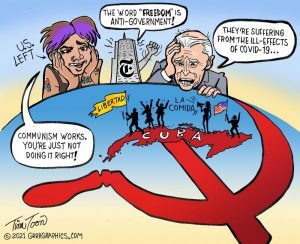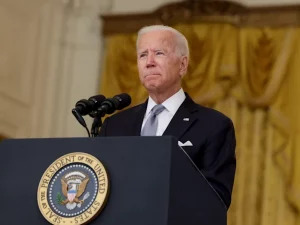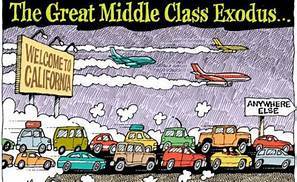Ronald E. Yates's Blog, page 46
October 12, 2021
Putting Things into Perspective: Suppose You Were Born in 1900
A few commentaries have been floating around the Internet for the past several years that have attempted to add a little perspective to the many critical issues and challenges we are facing today. I have adapted the contents of a couple of those to my essay here.
Essentially what those commentaries attempted to do was to put things into some kind of perspective. The problems confronting us today may seem unique and insurmountable. But are they?
Let’s do a cursory assessment of the way things are today.
For the past two years, we have dealt with the global Covid-19 pandemic and now we are seeing the steady erosion of our rights as vaccine and mask mandates are imposed on us by federal and state governments focused on incomparable control and overreach.
We live in a nation that appears woefully divided politically, socially, ethnically, and racially, As a result, we appear to be splitting into belligerent tribes. Parents are at war with local school boards over what they see as the Marxist indoctrination of their children via the teaching of specious Critical Race Theory.
We are on the cusp of record inflation. For example, food prices across the world have risen 32.8 percent to their highest levels in a decade on the back of tightening supply conditions, according to the Food and Agriculture Organization of the United Nations (FAO).
Wholesale fuel and gas prices have jumped 250% since January, pushing the average price of gas at the pump to $3.30 per gallon—the highest it’s been in the past seven years. In California, the average price of a gallon of gas just hit $4.42—the highest it’s been since 2012. Americans who heat their homes with natural gas are facing a 100 percent increase in their heating bills from a year ago, according to the Center for Strategic and International Studies.
Terrorism remains a constant threat especially since our wholesale withdrawal from Afghanistan where groups such as ISIS-K and a re-ascendant Al Qaeda will be allowed to flourish and plan attacks on Europe and the United States.
In short, our world is NOT a happy place. It is fraught with problems, antagonisms, and danger.
Now let’s try and put all of this into some kind of perspective by comparing and contrasting today’s world to the 101-year-long life of someone born in 1900. We tend to think of the past as a place where things were better, simpler, and more habitable. But is that really the case?
Imagine that you are born in 1900. It is a time of tremendous social and economic upheaval in the United States. Everything seems fairly tolerable until you reach the age of 14. That’s when World War I begins and lasts until you are 18 years old. By the time it’s over, an estimated 37 million people worldwide will have died, including 116,708 of your fellow Americans. You are still alive, but you may have lost friends and relatives in the conflict.
Just as the war ended, the world is struck by the 1918 Spanish Flu pandemic. By the time you’re 20, it has killed 675,000 Americans and at least 50 million people worldwide. You managed to survive the Spanish Flu, but you’re far from safe. There are still myriad other diseases and viruses out there with no cure or treatment, including polio, scarlet fever, and diphtheria. Smallpox remains rampant worldwide until the 1940s, killing some 300 million people during your lifetime.
It would be another nine years before penicillin is discovered in 1929, when you are 29—the same year that the Great Depression begins and the “Roaring Twenties” end. The Great Depression lasts 10 years. Unemployment hits 25%, global GDP drops 27%. The country nearly collapses along with the world economy. You and millions of other Americans spend countless days in long soup lines just to get something to eat.
Then, as you turn 39 and when you think things couldn’t get any worse, World War II begins in Europe. The U.S. manages to stay out of the conflict until 1941 when the Japanese attack Pearl Harbor, and America is hurled into the conflict.
When you’re 45, World War II ends. Some 80 million people have died, and of those 416,800 are Americans. It would be the deadliest war in history, killing 3% of the world’s population.
In 1946 there is a sense of hope that the carnage of World War II will usher in an era of peace and global cooperation. Unfortunately, peace doesn’t last.
When you turn 50, the Korean War begins and kills another 40,000 Americans as well as 5 million Korean deaths. The active war lasts three years. Theoretically, however, it has never ended because in 1953 a fragile armistice agreement that establishes the Korean Demilitarized Zone (DMZ) along the 38th Parallel is signed. That pact remains in effect today.
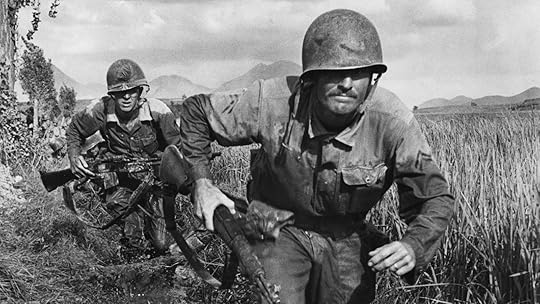
A year after the fighting in Korea ends you have just turned 54 and the Vietnam War begins between the Communist Viet Minh and the French, who colonized Indochina in the 19th century. The French are defeated by the Viet Minh in the decisive battle of Dien Bien Phu. French rule ends and under terms of the Geneva Accords Vietnam is divided at the 17th Parallel between the communist north and the nationalists in the south. It’s an uneasy arrangement and its violation will eventually bring about U.S. participation.
At the age of 57, you live through another global pandemic. The H2N2 Asian flu kills four million people worldwide and 116,000 in the United States. As with Covid-19, it originates in China.
Approaching your 62nd birthday you and millions of other Americans watch the Cuban Missile Crisis unfold. It’s a tipping point in the Cold War. The threat of nuclear war is real and life on our planet, as we know it, could well have ended. Cooler heads prevail and the ICBMs remain in their silos.
When you turn 65, U.S. Marines land on beaches near Da Nang beginning an almost 10-year-long American military involvement in the war. Some four million people will die during the war, including 58,000 Americans. During the war you watch America tear itself apart between those who support the war and those who don’t.

You experience the so-called “cultural revolution” of the 1960s along with major shifts in American values and ideology. You have never seen the nation so divided and at war with itself. The Civil Rights movement ends decades of segregation, but the assassinations of President John F. Kennedy, his brother Robert Kennedy, and Dr. Martin Luther King Jr. leave the nation in a state of prolonged depression.
When you are 68, the third influenza pandemic of the 20th century occurs. It’s called the H3N2 Hong Kong Flu and it kills almost four million people worldwide and 100,000 in the U.S.
As you turn 75, the Vietnam War ends, but the divisions created by the war in the United States remain.
When you are 81, an assassination attempt on President Ronald Reagan almost succeeds and there is a brand new virus to contend with that’s never been seen before called HIV-AIDS. It will kill hundreds of thousands in the US alone.
 Reagan assassination attempt 1981
Reagan assassination attempt 1981But your century is not over—not by a long shot.
When you are 91, you witness the collapse of the Soviet Union and when you turn 95 there is a domestic bomb attack on the Alfred P. Murrah Federal Building in downtown Oklahoma City killing 168, including 19 children under the age of 6. Four years later when you are 99, 15 people, including the shooters, are killed in the Columbine high school massacre.
Let’s say you live to 101—long enough to see America attacked by terrorists flying four hijacked airliners. You watch two planes crash into the twin world trade center towers in New York City, while another plane crashes into the Pentagon building in Washington and the fourth plane crashes into a Pennsylvania field when passengers take over the aircraft.
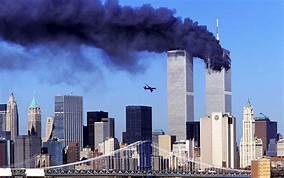
That was your century—the Twentieth. During that century you lived through several “hot wars” and for 36 of those years, you lived through the “Cold War” with the constant threat of nuclear annihilation hanging over your head.
British author C.S. Lewis, discussing the peril of living when the threat of a nuclear war was on everybody’s mind, had this to say in 1948 about existence during the “atomic age.” If you substitute the words “atomic bomb” with the words “Covid-19” you will see how relevant and spot-on his essay still is.
 C.S. Lewis, ca 1948
C.S. Lewis, ca 1948“In one way we think a great deal too much of the atomic bomb. ‘How are we to live in an atomic age?’ I am tempted to reply: Why, as you would have lived in the sixteenth century when the plague visited London almost every year, or as you would have lived in a Viking age when raiders from Scandinavia might land and cut your throat any night; or indeed, as you are already living in an age of cancer, an age of syphilis, an age of paralysis, an age of air raids, an age of railway accidents, an age of motor accidents.’
“In other words, do not let us begin by exaggerating the novelty of our situation. Believe me, dear sir or madam, you and all whom you love were already sentenced to death before the atomic bomb was invented: and quite a high percentage of us were going to die in unpleasant ways.
“We had, indeed, one very great advantage over our ancestors—anesthetics; but we have that still. It is perfectly ridiculous to go about whimpering and drawing long faces because the scientists have added one more chance of painful and premature death to a world which already bristled with such chances…and in which death itself was not a chance at all, but a certainty.
“This is the first point to be made: and the first action to be taken is to pull ourselves together. If we are all going to be destroyed by an atomic bomb, let that bomb when it comes find us doing sensible and human things—praying, working, teaching, reading, listening to music, bathing the children, playing tennis, chatting to our friends over a pint and a game of darts—not huddled together like frightened sheep and thinking about bombs. They may break our bodies (a microbe can do that) but they need not dominate our minds.”
C.S. Lewis puts things in remarkable perspective—just as someone who was born in 1900 and who lived to 2001 might have done.
What say you?
October 8, 2021
Big Brother has arrived in America and his name is Joe Biden.
President Biden declared this week that not only can U.S. Senators be harassed by demented leftists while doing their “business” in public bathrooms, but parents who protest too passionately at public school board meetings about how their children are being indoctrinated in classrooms will be investigated as “domestic terrorists” by the Department of Justice and a politically weaponized FBI, which seems to have morphed into America’s version of Nazi Germany’s Gestapo.
Attorney General Merrick Garland’s ham-fisted plan to engage federal, state, and local law enforcement to intimidate parents who protest the actions of leftist school boards is a direct assault on our First Amendment right to free speech.
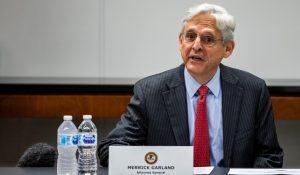 Merrick Garland: Protesting Parents = Domestic Terrorists
Merrick Garland: Protesting Parents = Domestic TerroristsIt is nothing more than an attempt to silence constitutionally protected grievances about brainwashing children with Marxist Critical Race Theory.
In a memorandum announcing the crackdown on parents, Garland said there has been a “disturbing spike in harassment, intimidation, and threats of violence against school administrators, board members, teachers, and staff.”
Garland added that he is directing the FBI to work with each U.S. attorney and leaders “in each federal judicial district” to discuss strategies to address threats and the rise in criminal conduct toward school personnel. The memorandum did not specify what it classifies as a crime.
A DOJ press release said Garland plans to “create specialized training and guidance for local school boards and school administrators. This training will help school board members and other potential victims understand the type of behavior that constitutes threats, how to report threatening conduct to the appropriate law enforcement agencies, and how to capture and preserve evidence of threatening conduct to aid in the investigation and prosecution of these crimes.”
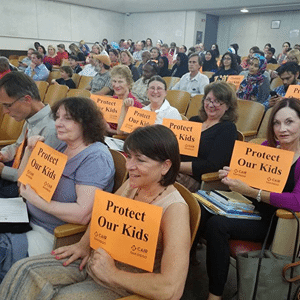 “Domestic Terrorists” in Action
“Domestic Terrorists” in ActionThe Biden administration’s blatant attempt to shut down protests from parents is not just at the federal level. In the hotly-contested Virginia gubernatorial race, the two candidates debated the issue last week and the incumbent Democratic Governor Terry McAuliffe agreed with Garland’s intimidation tactics.
“Parents should have no say in how their children are educated,” Virginia’s McAuliffe, argued. “I don’t think parents should be telling schools what they should and should not teach.”
Really?
His Republican challenger, Glenn Youngkin, begged to differ, as I suspect do millions upon millions of American parents.
“What we’ve seen over the course of this last 20 months is our school systems refusing to engage with parents,” Youngkin said. “In fact, in Fairfax County this past week, we watched parents so upset because there was such sexually explicit material in the library they had never seen, it was shocking. I believe parents should be in charge of their kids’ education.”
There is little doubt that Youngkin’s view is in the majority throughout the nation as parents angry about Marxist political indoctrination and overly-explicit sexual instruction provided to children as young as five engage with school boards.
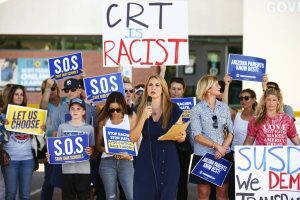 More “Domestic Terrorists” in Action
More “Domestic Terrorists” in ActionReaction to the federal government overreach has been swift and vocal.
Florida Gov. Ron DeSantis lambasted Garland for “weaponizing the DOJ by using the FBI to pursue concerned parents and silence them through threats and intimidation. Florida will defend the free speech rights of its citizens and will not allow federal agents to squelch dissent.”
Republican Sen. Josh Hawley agreed, calling Garland’s plan a “dangerous abuse of power.”
“Now Joe Biden is deploying the FBI against parents who have concerns about Critical Race Theory being taught to their children,” Hawley said in the Senate earlier this week “This is a remarkable and dangerous abuse of power. I just asked the Biden DOJ to name one instance in American history when the FBI has been directed to go after parents attending school board meetings to express their views. There isn’t one. Biden’s latest offensive against parents is shocking, unprecedented, and wrong.”
Indeed. The First Amendment protects all speech unless it explicitly calls for the use of force that the speaker clearly intends and the likelihood of violence is real and imminent. Even actual “threats of violence” are not actionable unless they meet this high threshold.
In 1783 George Washington, who Garland and Biden along with their socialist and Marxist friends, clearly loathe, articulated some prophetic words about free speech.
“For if men are to be precluded from offering their sentiments on a matter, which may involve the most serious and alarming consequences, that can invite the consideration of Mankind, reason is of no use to us; the freedom of Speech may be taken away, and, dumb and silent we may be led, like sheep, to the Slaughter.”
That is apparently what Garland and Biden have in mind for angry and outspoken parents.
I predict that the DOJ and the FBI will make an example of a couple of the more vociferous and angry parents in the hopes of silencing hundreds of thousands of others.
I also predict that ploy will backfire on the Biden administration when more and more parents refuse to be gagged and silenced.
Apparently, the Biden administration wants America transformed into a police state and we seem to be heading in that direction.
Nicole Neily is one parent who is not backing down.
“It is shameful that activists are weaponizing the U.S. Department of Justice against parents,” Neily, president of Parents Defending Education, said in response to the memorandum. “This is a coordinated attempt to intimidate dissenting voices in the debates surrounding America’s underperforming K-12 education—and it will not succeed. We will not be silenced.”
John Stuart Mill may have said it best back in 1859 when he said:
“Strange it is that men should admit the validity of the arguments for free speech but object to their being ‘pushed to an extreme,’ not seeing that unless the reasons are good for an extreme case, they are not good for any case.”
Amen to that.
October 6, 2021
The American Descent into Madness
I occasionally re-post commentaries by Victor Davis Hanson, who is a distinguished fellow of the Center for American Greatness and the Martin and Illie Anderson Senior Fellow at Stanford University’s Hoover Institution. Hanson is always lucid and logical in his approach to the issues and problems facing America. Here he asks and then answers the following question: “America went from the freest country in the world in December 2019 to a repressive and frightening place by July 2021. How did that happen?”
The American Descent into Madness
Nations have often gone mad in a matter of months. The French abandoned their supposedly idealistic revolutionary project and turned it into a monstrous hell for a year between July 1793 and 1794. After the election of November 1860, in a matter of weeks, Americans went from thinking secession was taboo to visions of killing the greatest number of their fellow citizens on both sides of the Mason-Dixon line. Mao’s China went from a failed communist state to the ninth circle of Dante’s Inferno, when he unleashed the Cultural Revolution in 1966.
In the last six months, we have seen absurdities never quite witnessed in modern America. Madness, not politics, defines it. There are three characteristics of all these upheavals. One, the events are unsustainable. They will either cease or they will destroy the nation, at least as we know it. Two, the law has largely been rendered meaningless. Three, left-wing political agendas justify any means necessary to achieve them.
Citizenship as Mere Residency
Two million people are anticipated to cross the southern border, en masse and illegally, over a 12-month period. The new arrivals have three things in common: Their first act was to break U.S. law by entering the country. Their second was to break the law by residing here illegally. And their third will be to find false identification or other illegal means to continue breaking the law. One does not arrive as a guest in a foreign country and immediately violate the laws of his host—unless one holds those laws in contempt.
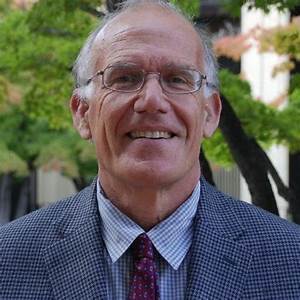 Richard Davis Hanson
Richard Davis HansonArrivals now cross a border that had been virtually closed to illegal immigration by January 2021. In the cynical and immoral logic of illegal immigration (that cares little for the concerns either of would-be legal immigrants or U.S. citizens), arrivals will be dependent upon the state and thus become constituents of progressives who engineered their arrival.
Yet the issue is not illegal immigration per se. If protests were to continue in Cuba, and 1 million Cubans boated to Miami, the Biden Administration would stop the influx, in terror that so many anti-Communists might tip Florida red forever.
How strange that the U.S. government is considering going door-to-door to bully the unvaccinated, even as it ignores the daily influx of thousands from Mexico and Latin America, without worrying whether they are carrying or vaccinated for COVID-19. Meanwhile, the progressive media shrilly warns that the new Delta Variant of the virus is exploding south of the border. Note how the administration applies standards to its own citizens that it does not apply to foreign nationals illegally entering the country.
Crime as Construct
Crime is another current absurdity. There exists a mini-industry of internet videos depicting young people, disproportionately African American males, stealing luxury goods from Nieman-Marcus in San Francisco, clearing a shelf from a Walgreens with impunity, or assaulting Asian Americans. These iconic moments may be unrepresentative of reality, but given the mass transfers and retirements of police, and the frightening statistics of large increases in violent crime in certain cities, the popular conception is now entrenched that it is dangerous to walk in our major metropolises, either by day or at night. Chicago has turned into Tombstone or Dodge City in the popular imagination.
Scarier still is the realization that if one is robbed, assaulted, or finds one’s car vandalized, it is near certain the miscreant will never be held to account. Either the police have pulled back and find arrests of criminals a lose-lose situation, or radical big-city district attorneys see the law as a critical legal theory construct, and thus will not enforce it. Or the criminal will be arrested and released within hours.
So a subculture has developed among Americans, of passing information about where in the country it is safe, where it is not, and where one can go, where one cannot. This is clearly not America, but something bizarre out of Sao Paulo, Durban, or Caracas.
The Campus Con
The universities over the past 40 years were intolerant, hard Left, and increasingly anti-constitutional. But they also fostered a golden-goose confidence scheme that administrators dared not injure, given the precious eggs of federally guaranteed student loans that ensured zero academic accountability and sent tuition costs into the stratosphere. There was an unquestioned supposition that a degree of any sort, of any major, was the ticket to American success. In cynical fashion, we shrugged that most prestigious institutions were little more than cattle branders that stamped graduates with imprints that gave them unearned privilege for life.
Yet universities now have both hands around their golden goose’s neck and are determined to strangle it. The public is becoming repulsed at the woke McCarthyite culture on campus, and will be more turned off when campuses open in the fall in 2019-style. At the Ivy League or major state university campuses, admissions are no longer based on proportional representation in the context of affirmative action, but are defined increasingly by a reparatory character.
Grades, test scores, and “activities” of the white and Asian male college applicants are growing less relevant. Only “privileged” white males with sports skills, connections, or families who give lots of money are exempt from the new racial reparation quotas. The new woke admission policy ironically is targeting the liberal suburban professional family, the Left’s constituency, whose lives are so fixated on whether children graduate from Yale, Princeton, Harvard, Stanford, or like campuses.
Given the radical change in incoming student profiles, the faculty increasingly will have to choose between accusations of racism, or grading regardless of actual performance, given thousands of new enrollees do not meet the entrance standards of just two or three years ago. Remember that since wokeism was always a top-down elite industry, minority progressives still will fight it out with white leftists in intramural scraps over titles, salaries, and managerial posts.
The public has had enough. For the first time, people will ask why are we subsidizing student loans, why are multibillion-dollar endowments not taxed, and why do we think a B.A. in sociology or psychology or gender studies is an “investment” that prepares anyone for anything?
Commissars and Jacobins
The critical race theory craze is reaching peak woke, or is already on the downslope. No complex and sophisticated society is sustainable with a Maoist creed of cannibalizing citizens for thought crimes. Commissars do not produce anything or serve anybody, but only monitor thoughts and speech to ascertain the purity of diversity, equity, and inclusion. They are not just a drain on the productive sector but will insidiously destroy it, since their currency is to ensure a timid, obsequiousness and banal orthodoxy.
We know from the failed Soviet system and from the French Revolution that the most mediocre in society became its most eager auditors of correct behavior. The arbiters of proper thought—the self-righteous paid toady, the perpetual victim employed in service to government payback, the freelancing snitch—were always the villains of freedom, productivity, and humanity, whether we read of the killing off of Alexander the Great’s inner circle, the forced suicides of the Neronian circle, the Jacobin murder spree, or the nightmarish world described by Aleksandr Solzhenitsyn.
That the Biden Administration has now joined with Silicon Valley to hunt down on social media any dissenters from this month’s official policy on vaccinations and mask-wearing was not so shocking as to be expected from a media that banned coverage of Hunter Biden’s laptop. In Cuban fashion, millions of judge-jury-executioner online snitches, with government encouragement, will help root out incorrect thoughts at light speed.
Inflation Is a Mere Construct
We used to know what inflation was, its pernicious role in past civilizations, and how to combat it. The danger of worthless currency is a staple of classical literature from Aristophanes to Procopius. The scary fact is not just that we are destroying the value of our money—the exploding price of gas, food, appliances, lumber, power, and housing are overwhelming even Joe Biden’s entitlement machine—but that we are constructing pseudo economics to justify the nihilism.
Right now, we witness a multitrillion-dollar fight over borrowing beyond our $30 trillion debt to build “infrastructure,” a word that has been expanded to include almost anything but roads and bridges. What exactly is so liberal about the farmworker paying $5 a gallon for gas to commute to the fields, the small contractor doing a remodeling job with plywood at $80 a sheet, or the young couple whose loan qualification is always a month behind the soaring price of a new home?
Our People’s Military
Americans during this entire descent in madness sighed, “Well, at least there is the military left.” By that, I think they meant John Brennan had all but wrecked the CIA, while James Comey, Andrew McCabe, Kevin Clinesmith, Peter Strzok, and Lisa Page, et al. had weaponized the FBI. But the military was still a bastion of traditional, nonpartisan service, whose prime directive was to defend the country, win any war it was ordered to fight, and to maintain deterrence against opportunistic enemies. It was not envisioned as a “people’s army.” It was not a revolutionary Napoleonic “nation in arms.” And it was not a “liberation army.” The Constitution, 233 years of tradition, and the Uniform Code of Military Justice all reassured America of its wonderful defense forces.
And now? We are in the process of a massive reeducation and indoctrination campaign. The revamping not only draws scarce resources away from military readiness, but targets, without evidence, the white working class, and defames it as insurrectionary—the very same cohort that disproportionately died in Afghanistan and Iraq.
If only General Mark Milley, chairman of the Joint Chiefs of Staff, and Admiral Michael Gilday, chief of naval operations, had been as animated, as combative, and as fired up in congressional testimony about winning in Afghanistan or deterring the Chinese in the waters off Taiwan as they were in defense of their recommended lists of Marxist-inspired critical race theory texts!
One purpose of the Uniform Code of Military Justice was not to prevent retired top brass from attacking beloved presidents, or even blasé ones. Its aim was to remind the country that it is the business of civilians, not pensioned retired military subject to recall in times of crisis, to galvanize opinion against loudmouth unpopular presidents like Harry Truman, Richard Nixon, or Donald Trump.
The reason why the “revolving door” became a bipartisan worry was that four-star officers had mastered the navigation of Pentagon procurement. They possessed a rare skill easily—and hugely—monetized upon retirement, and thus its use was to be discouraged wholeheartedly.
And now?
The code is a mere construct. The revolving door is an advertisement for advancing to a high rank. Policing the thoughts of American soldiers is apparently more important than fathoming the minds of our enemies on the battlefield.
Keep Cuba Castroite?
What was so hard about understanding that Cuba since 1959 has been a Communist gulag, antithetical to human freedom and consensual government? What was so difficult about conceding that Cuba had been an ally of the nuclear Soviet Union, always egging it on to war against the United States?
Yet here we are with protestors against a failed, evil state in the streets of Havana, and our own government, media, and professional classes are worried that ossified Communism in Cuba may fall.
After opening the U.S. southern border to pseudo-political refugees, the Biden Administration is terrified that thousands of real ones might come to Miami in the fashion it invited millions to storm into Texas. The Biden Administration, and the Left in general, finally revealed what many of us have known: it had no real ideological view on illegal immigration. Its immigration policy was entirely utilitarian and hinged only on whether illegal immigration altered the demography of the electorate in the correct way.
The United Nations Über Alles
Finally, almost all Americans used to agree that the U.S. Constitution was unique and guaranteed personal freedom in a way the United Nations charter could not. Dozens of fascist, Communist, totalitarian, and authoritarian regimes, usually the majority of governments on earth, ensured that any General Assembly or U.N. committee ruling would parrot the views of its illiberal and corrupt members.
Not anymore. Biden’s secretary of state, Antony Blinken, has invited in the U.N. to assess whether the United States meets global standards of justice or, in fact, is racist and in need of global censure: “I urge all U.N. member states to join the United States in this effort, and confront the scourge of racism, racial discrimination, and xenophobia,” he said last week.
That is like asking Libya in 2001 to assess whether our airline pilot training met proper standards or having China adjudicate the conditions in U.S. prisons.
America went from the freest country in the world in December 2019 to a repressive, and frightening place by July 2021. It went not so much hard-Left, as stark-raving mad.
That abrupt descent, too, is not workable and millions will collectively decide they have no choice but to push back and conclude, “In the 233rd year of our republic, we tens of millions are not going to cede freedom of thought and expression to thousands of Maoists. Sorry, no can do.”
About Victor Davis Hanson
Victor Davis Hanson is a distinguished fellow of the Center for American Greatness and the Martin and Illie Anderson Senior Fellow at Stanford University’s Hoover Institution. He is an American military historian, columnist, former classics professor, and scholar of ancient warfare. He has been a visiting professor at Hillsdale College since 2004. Hanson was awarded the National Humanities Medal in 2007 by President George W. Bush. Hanson is also a farmer (growing raisin grapes on a family farm in Selma, California) and a critic of social trends related to farming and agrarianism. He is the author most recently of The Second World Wars: How the First Global Conflict Was Fought and Won and The Case for Trump.
October 4, 2021
Why are We Allowing American Marxists to Destroy Our Nation?
The other day I was thinking how alarming it is that so many Americans today are embracing socialism and even communism. As a result, more and more of our precious freedoms are being eroded by unprecedented government overreach and repression.
From vaccine and face mask mandates to the Marxist indoctrination of our children in public schools; from President Biden’s idiotic invitation for the world to stampede across our open borders to irresponsible and unprecedented spending of trillions of dollars we don’t have; to plans to give the IRS unparalleled access to our previously private banking information to the steady erosion of our First and Second Amendment rights.
This is what we are seeing under America’s first blatantly socialist government.
How can this be happening? Are Americans suddenly a nation of obedient and vulnerable sheep? How long will we allow ourselves to be herded hither and thither by Washington’s authoritarian sheepdogs?

And what of our rights that are guaranteed by America’s Constitution? Why are we allowing those rights to be devoured by packs of tyrannical wolves in Washington and elsewhere?
One of Ronald Reagan’s most prescient comments about this country came in a speech he made way back in 1961.
“Freedom is never more than one generation away from extinction,” he said. “We didn’t pass it on to our children in the bloodstream. The only way they can inherit the freedom we have known is if we fight for it, protect it, defend it, and then hand it to them with the well-fought lessons of how they in their lifetime must do the same. And if you and I don’t do this, then you and I may well spend our sunset years telling our children and our children’s children what it once was like in America when men were free.”
It boggles the mind that so many of my fellow Americans don’t understand just how fragile the freedoms are that too many of us take for granted.
In his book, American Marxism, Mark Levin writes: “We have allowed the American Marxists to define who we are as a people. They defame us, slander our ancestors and history, and trash our founding documents and principles. They are mostly reprobates who hate the country in which they live, and have contributed nothing to its betterment.”
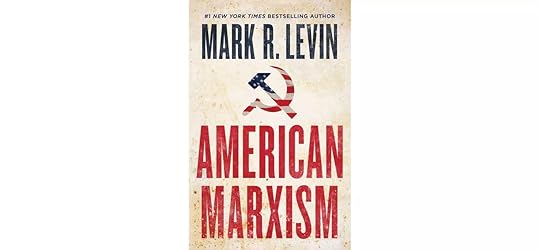
Levin continues: “The time has come to reclaim what is ours—the American Republic—from those who seek to destroy it. If we expect others to rescue our nation for us, as we go about our daily lives as mere observers to what is transpiring, or close our eyes and ears to current events, we will lose this struggle. And yes, it is a struggle.”
Levin couldn’t be more accurate in his appraisal. Too many of us have grown complacent or oblivious to what is happening in America.
More than two million illegal migrants are expected to overrun our nation in 2021 while Emperor Biden fiddles in the White House. If that continues year after year, that means we will be inundated with the illegitimate equivalent of a major American city every year. Meanwhile, the Democrats who rule Congress and the White House don’t care because they know those illegal aliens they are welcoming will someday be Democrat voters—either legal or illegal. For most Democrats in Congress, it’s all about the party, not the country. For Democrats in power, it’s all about maintaining their control at all costs–even at the expense of our Republic.
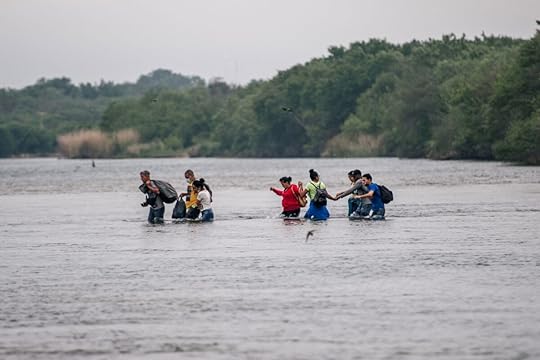 Migrants illegally crossing the Rio Grande River into the U.S. from Mexico
Migrants illegally crossing the Rio Grande River into the U.S. from MexicoIf the progressive wing of the Democratic Party has its way, this aberration will continue until we have a one-party socialist/communist government.
Unless Democrats are pushed out of power in 2022, the socialist wing of the party (AOC and the other “useful idiots” of her “squad”) will continue to inflict their Marxist agendas on us—things like anti-white and racist Critical Race Theory; Maoist-inspired “thought crimes” punishable by being summarily “canceled;” Marxist pseudo economics and rampant inflation; a “woke” and feeble military led by socialist generals; a duplicitous strategy to federalize and micromanage the election process currently administered by the states; and a scheme to surrender some of our hard-earned freedoms in the Bill of Rights to a corrupt, anti-American United Nations.
Meanwhile, crime in our nation continues to accelerate because of an irrational, socialist-inspired “defund the police” movement that debases the men and women who are paid to protect us from the now emboldened predators who prey on society.
Videos of young people, primarily African American males, assaulting Asian Americans, stealing luxury merchandise from stores in Chicago, San Francisco, and other cities, and clearing out shelves in stores such as Apple, Target, and Walgreens with impunity, are disgusting and are more applicable to a third-world backwater than to the most powerful nation in the world.
 Thieves in black hoodies casually steal $27,000 of Mac Gear from an Apple Store in Chicago while employees and customers look on
Thieves in black hoodies casually steal $27,000 of Mac Gear from an Apple Store in Chicago while employees and customers look onWhy do we allow this to happen? Why do we tolerate such lawlessness? Is it because Marxist groups like Black Lives Matter, ANTIFA, and AOC’s racist and anti-Semitic “squad” support and encourage such nihilist behavior as part of their effort to obliterate our nation?
Police appear paralyzed as these swaggering sociopaths and thieves are encouraged by our indifference and inaction.
On top of all of this are Marxist tactics and strategies designed to divide our nation racially, ethnically, socially, religiously, and politically. Groundless charges of “white supremacy,” “white fragility,” and “white privilege” are designed to convince us that we have somehow returned to 19th century America when some four million black men, women, and children were plantation slaves and a few thousand whites were their masters.
The facts tell a much different story. It’s a story of progress and equality, says the U.S. Congressional Joint Economic Committee in a 2020 report entitled: “The Economic State of Black America.”
“Over the past half-century, Black Americans have made substantial social and economic progress, gaining political rights that long had been denied to them, entering professions from which they had been blocked and largely overcoming centuries of overt racism and oppression,” the report by one of four standing joint committees of Congress, said.
“While there were only five Black Members of Congress when the Civil Rights Act became law in 1964, there currently are 56 Black Members of Congress, including 12% of the House of Representatives. Black activists, scholars, and social commentators have raised awareness about the importance of diversity and shaped the national conversation around race and inequality.
“There has been a proliferation of Black writers, screenwriters, artists, poets, athletes, and musicians who have become superstars in their respective fields. And the 21st century saw the election of the first Black American, Barack Obama, as president of the United States.”
Yet, the racist and Marxist rhetoric from the left continues to push the false narrative that America’s black population has made no progress since the end of the Civil War in 1865.
Hence, the racist rants directed at whites by BLM, Antifa, and other racist/Marxist organizations.
In schools that teach racist Critical Race Theory, white children as young as five and six years old are portrayed as “oppressors,” while minority children are told they are the “victims” of that oppression. Instead of teaching children to respect one another and get along, Critical Race Theory agitators and Marxists posing as teachers are driving wedges between impressionable children and thereby creating an atmosphere of hatred and distrust.
 Critical Race Theory in Action in the Classroom
Critical Race Theory in Action in the ClassroomI find all of this appalling. But most of all, I see grave danger in it. Once the socialists and Marxists have segregated us into manageable tribes based on race, religion, ethnicity, social and economic status, they will have achieved their “divide and conquer” goal.
While that has not yet happened, this is nevertheless, NOT the country in which I was born and reared. This is an aberration, a grotesque deformity of the nation I proudly served in the U.S. Army. When I was in the Army, I was trained to battle and conquer communists and their socialist cousins.
Countries such as Communist China, North Korea, Cuba, the old Soviet Union, and the Warsaw Pact nations were our political and military enemies, and they were single-minded in their goal to destroy us.
Times have changed. Today, those enemies are not just “over there.” They are here, inside our Republic, working to destroy us from within. They are in Congress, they are in charge of our boards of education, they are in our bureaucracies, in our military, our Big Tech companies, and in our corporations. They will not stop until they rip apart our Constitution, destroy our cherished, if neglected freedoms, and create a one-party oligarchy.
Look at how powerful Big Tech companies are censoring free and open speech that was once considered an inalienable right. Today speaking out against socialism, government overreach, and those in power will get you censored, banned from social media platforms, and, even worse, “canceled.”
That is the country the deceitful and treacherous Marxists and socialists in Washington want and as long as most Americans behave like flocks of submissive sheep, they will achieve their objectives.
God help us all if they do.
September 30, 2021
A “General” Embarrassment: ‘Lyin’ Biden’ does it again!
Do you remember this exchange last month between President Biden and ABC’s George Stephanopoulos? If you don’t, here’s how it went:
Stephanopoulos: “Your top military advisers warned against withdrawing on this timeline. They wanted you to keep 2,500 troops.”Biden: “No, they didn’t. That wasn’t true.”Stephanopoulos: “Your military advisers did not tell you that, ‘No, we should just keep 2,500 troops. It’s been a stable situation for the last several years. We can do that. We can continue to do that.’?”Biden: “No, no one said that to me that I can recall.” Stephanopoulos & Biden
Stephanopoulos & BidenWhen I heard Biden utter those words, I knew he was lying. I spent 3-1/2 years on active duty in the U.S. Army and I learned that even the most inept military commander knows that you never remove all of your troops from a city and THEN commence with an evacuation of civilians.
Biden’s lies were exposed again and again during Tuesday’s Senate Armed Services Committee hearings and then during yesterday’s House Armed Services Committee hearings.
During testimony before those committees Defense Secretary Lloyd Austin, Joint Chiefs Chairman General Mark Milley, and head of U.S. Central Command General Kenneth McKenzie, all said they had advised Biden to keep at least 2,500 troops in place in Afghanistan.
“I recommended that we maintain 2,500 troops in Afghanistan,” McKenzie testified. “I also have a view that the withdrawal of those forces would lead inevitably to the collapse of the Afghan military forces and eventually the Afghan government.”
 Gen. McKenzie
Gen. McKenzieMcKenzie was right and so was General Austin “Scott” Miller, our nation’s last commander in Afghanistan, and Biden ignored his expert advice as well.
Milley’s assessment was similar: “I said, we should keep a steady state of 2,500 and it could bounce up to 3,500, maybe, something like that, in order to move toward a negotiated solution.”
Secretary of Defense Austin made it clear that Biden got the message: “Their (the generals) input was received by the president and considered by the president, for sure.”
[image error] Sec. Defense Austin & Gen. MilleySo there you have it. The president ignored the advice of his senior military leaders. That’s his privilege, even if he wishes to lie about it.
But Biden is a habitual liar and plagiarist and has been for most of the 40-plus years he and his corrupt family have been gorging themselves at the public trough.
In 1987-88 he claimed:
He was the only one in his class to go to law school on a full scholarship.He graduated in the top half of his class.He was the outstanding student in his political science class.He graduated with three degrees, earning 165 credits when he only needed 123.Sorry folks. Those are all lies. Here’s the truth as uncovered by the media:
He had a 1/2 scholarship that was needs-based.He ended up near the bottom of his class: 76th in a class of 85 at his law school.He was not the outstanding political science student.He graduated with only one degree, and barely at that.Biden didn’t stop there. In various speeches, the media (once upon a time, they actually did their jobs) revealed that Biden had plagiarized British Labor Leader Neil Kinnock, Bobby Kennedy, John F. Kennedy, and Hubert Humphrey.
They also revealed that he cheated in law school, plagiarizing others’ work. Biden acknowledged that he plagiarized a law review journal for a paper during law school at Syracuse. He asked school administrators not to expel him, saying he “made a mistake in the citation process.”
When cornered about his lies, Biden said, “I’ve done some dumb things, and I’ll do dumb things again.”
Guess what? Biden was right. He has done dumb things and he continues to do dumb things.
And now that millions of Democrats with short memories or who are politically comatose have elected this compulsive liar and plagiarist to the nation’s highest office, all of us are suffering for it.
Just look at the humanitarian catastrophe on our Southern border, the inflation that is devastating our economy, and the calamity of our withdrawal from Afghanistan.
Then, there is his despotic management of the pandemic by ordering mandated vaccinations—a move that has created an enormous credibility gap because just eight months ago, he said he would never mandate Covid-19 vaccinations.
But, hey, that’s good ole Joe for ya. You believe this man at your own risk.
Me? I stopped believing this prevaricator decades ago.
Too bad we have millions of voters today who either don’t care if they elect a fraud and a cheat to the White House as long as he’s a Democrat, or who are too naïve to see how deceitful and devious Biden is.
I tend to think it is the former, not the latter.
September 27, 2021
Herding Haitians. Lies and More Lies about Our Mounted Border Patrol
Last week border patrol agents on horseback near Del Rio, Texas were seen using their long reins to control their horses as they drove migrants attempting to illegally cross the border back into the Rio Grande River.
What we saw WAS NOT a return to slavery, as fatuous California congresswoman Maxine Waters insisted during one of her typically hysterical rants.
Anybody who has ever ridden a horse—and clearly most of the oblivious leftist media and their Democrat masters in Congress fall into that category—know that those agents weren’t “whipping” Haitians with their long reins, but using them to keep their skittish horses under control as Haitians attempted to grab bridles and bits.
But hey, never let the facts get in the way of yet another sham narrative about racial intolerance.
Here’s what Waters and a flock of other misinformed useful idiots said after looking at photos and videos of mounted Border Patrol agents doing their jobs.
 Useful Idiot “Mad” Maxine Waters
Useful Idiot “Mad” Maxine Waters“We’re saying to the president and to everybody else, you’ve got to stop this madness,” Waters screamed to a compliant and obedient media outside Capitol Hill Wednesday. “And I want to know, in the first place, who’s paying these cowboys to do this work? They have got to be gotten rid of. They’ve got to be stopped. It cannot go on. They are trying to bring us back to slavery days and worse than that.”
White House press secretary Jen Psaki repeatedly called the images “horrific.”
Dumb as a rock Rep. Alexandria Ocasio-Cortez, called agents’ actions a “stain on our country,” while Congress’s resident anti-Semitic Rep. Ilhan Omar, said it was “cruel, inhumane, and a violation of domestic and international law.”
What the mounted agents did was, in fact, standard operation procedure and well within the laws of the land.
 Mounted border patrol agents pushing illegal migrants back into the Rio Grande
Mounted border patrol agents pushing illegal migrants back into the Rio GrandeMaybe a little historical perspective and context is required here. Unlike the frenzied socialist media, agitated members of Congress, and our stumbling, bumbling president, who quickly piled on the border patrol agents, I have done some research into our mounted border patrol agents.
Horses have been used since 1904 when “Mounted Guards,” or inspectors of the now-defunct U.S. Immigration Service patrolled the southern border of the U.S.
The guards once operated out of El Paso, Texas, and patrolled as far west as California, on the lookout for migrants trying to illegally cross the border.
Horses were more valuable to the agents than uniforms – which would come four years later. New recruits furnished their own horse and saddle, while the government supplied oats and hay for the animals.
 Mounted Border Patrol Agent Ca 1930
Mounted Border Patrol Agent Ca 1930Then, in 1924 the U.S. Border Patrol was established after Congress passed the Labor Appropriation Act. Its mission was to secure the borders between inspection stations and patrol the seacoast. In 1935 the Border Patrol began using motorized vehicles, but to this day, agents use horses to traverse terrain inaccessible to other means of transit.
The fact is those mounted agents (not “cowboys,” as Waters insisted) were doing their jobs last week trying to keep Haitian and other migrants from entering our nation illegally. They have been doing that for more than 100 years.
It is interesting to note that Department of Homeland Security Secretary Alejandro Mayorkas and Border Patrol Chief Raul Ortiz both said last Monday that they did not see anything wrong with the images, and Mayorkas even pointed out agents use long reins to control their horses, not whips, in difficult terrain. Ortiz also noted that agents often can’t tell the difference between smugglers and migrants.
How quickly both Mayorkas and Ortiz changed their tunes when our somnolent President opened his mouth and let fly with this threat:
“It’s outrageous, I promise you, those people will pay,” Biden said.
 What, me worry? I’m the President
What, me worry? I’m the PresidentNever mind that those “people” were just doing their jobs and following long-established and lawful practices.
But Biden, egged on by frenzied reporters, continued to disparage and threaten our mounted border patrol agents.
Here is his rambling, muddled comment to reporters last week:
“I’m president but it was horrible to see what you saw, to see people treat it like they did — horses nearly running over people being strapped. It’s outrageous, I promise you, those people will pay. They will be — there is investigation underway now, and there will be consequences. There will be consequences. It’s an embarrassment, beyond an embarrassment. It’s dangerous. It’s wrong, it sends the wrong message around the world, sends the wrong message at home. It’s simply not who we are.”
The Border Patrol agents’ union quickly disputed Biden’s characterization.
“Even though the White House acknowledged there is an ongoing investigation, saying that the agents “will pay” shows that they aren’t truly interested in the results. The photographer who took the photos said that nobody was whipped. Deciding they did something wrong without any form of due process — that should not be who we are,” Border Patrol Council Vice President Jon Anfinsen said.
Some Democrats and media outlets falsely described the agents’ long reins, which they use to control their horses, as “whips.”
House Speaker Nancy Pelosi, yet another useful idiot condemned what she described as “the inappropriate use of what appear to be whips by Border Patrol officers on horseback to intimidate migrants.”
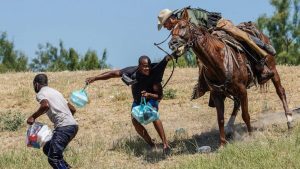 Haitian migrant attempting to grab horse’s bridle and bit
Haitian migrant attempting to grab horse’s bridle and bitWith a little basic knowledge and two brain cells, anyone knows those agents use split reins. They do use them as a whip, on their horse’s necks. This helps get a quicker response from the horse, especially when the horse may be hesitant with groups of people or other animals.
Here’s a fact. We have a president who is unconcerned about those crossing our border illegally—and has, in fact, invited them to do so by opening our borders. He seems oblivious to the fact that un-vetted illegal aliens are streaming by the hundreds of thousands into our country—many unvaccinated and infected with Covid-19.
The National Border Patrol Council, the union representing border patrol agents, issued a statement Tuesday condemning the “outrageous claims by the Biden administration.”
It said that Psaki, as well as Department of Homeland Security Secretary Mayorkas, “made outlandish and irrational claims about being horrified by images that show Border Patrol agents on horseback using authorized equipment and techniques to deter and prevent a large group of people from illegally entering the United States in Del Rio, Texas.”
The union slammed the Biden administration for having the privileged position to complain about the border crisis which it argued it largely enabled by relaxing border restrictions and exacerbated by not providing border patrol agencies the guidance and resources to deal with it.
“Again it is clear that those ‘in charge,’ a term that is disgusting to use, have no clue about our operations and frankly operate by ignorance and unhinged emotions,” the union said.
Rather than being punished those agents on horseback should be given medals for enforcing American immigration laws despite the Biden administration’s opposition and unwarranted attacks.

We all know what is going on here. It’s really quite simple. The Biden administration and the Democrat party see these hundreds of thousands of illegal immigrants pouring across our borders month after month as potential Democrat voters. The more illegals the Biden administration allows to break our laws and cross our borders, the more voters—legal and illegal—the Democrat party gains and the longer socialists can remain in power.
The agents we saw on horseback doing their jobs have been suspended or relieved of their duties. That is outrageous. It’s Biden the confirmed plagiarist and habitual liar who should step down before he completely destroys our nation.
September 22, 2021
YIKES! My Mayor is getting the Hell out of California
I live in a place called Murrieta. It’s a city of about 100,000 in Southern California’s wine country, just about 50 miles north of San Diego.
Murrieta is a nice mid-sized town situated in rolling hills about 20 miles from the Pacific Ocean and maybe 30 miles from a couple of soaring mountain ranges.
 Murrieta: A great place to live
Murrieta: A great place to liveWe have access to the best of all worlds: wine, sandy beaches, pine trees, snow and skiing, the state’s largest Native-American casino, and a couple of well-appointed malls.
It’s a well-managed town with one of the nation’s lowest crime rates and plenty of affordable housing.
Well, I may be fibbing a bit there. Murrieta is well managed, and our crime rate is very low, but I’m stretching the truth when it comes to affordable housing. The median price of a single-family home in Riverside County, which is where Murrieta is located, is just a little south of $600,000.
Okay, so that’s almost three-fourths of the way to $1 million and that’s a negative.
But that doesn’t negate all of the positives, so why is our Mayor Scott Vinton resigning and hightailing it to Tennessee? After all, Vinton is a native Californian who has lived his entire life in the Golden State.
 Murrieta Mayor Scott Vinton
Murrieta Mayor Scott VintonSo what gives, Mayor Vinton?
“It is with a heavy heart that I have made the personal choice to step down from my elected position,” Vinton wrote in his letter of resignation. “Although it was my full intention to serve my entire four-year term, my wife and I have made a life decision to relocate to Tennessee to build our forever home.”
Tennessee is one of the states that thousands of Californians are fleeing to, along with Texas, Florida, Idaho, and Nevada.
“Many circumstances over the last 18 months have led us to move our original date of spring 2023 to the end of 2021,” Vinton continued.
Ah-ha! “Many circumstances” have led to this decision to bail on Murrieta. Just what might some of those be?
“I’ve been a Southern Californian my whole life, and my wife and I are looking to go someplace new with no income taxes, a place where we feel at home,” he said. “California has changed a lot since I’ve grown up.”
And there you have it.
The Vinton’s no longer feel at home in California. In that respect, they speak for hundreds of thousands or perhaps millions of other California residents.
California is driving people away with its array of high taxes. It has the highest state sales tax rate (7.25%) in the nation and California’s top tier income tax rate is the highest in the nation at 13.3 percent, according to the Tax Foundation and California Taxpayers Association.
Per capita, Californians pay about $2,000 annually in state income taxes, which ranks fourth highest in the country, according to the Tax Foundation. It has the 7th-highest corporation tax rate (flat tax of 8.84%) in the nation.
But reading between the lines, I can see that California’s onerous taxes are not the only reason Mayor Vinton is heading for the hills of Tennessee.
“California has changed a lot since I’ve grown up,” he said.
Ain’t THAT the truth?
I first came to California in 1976. The state was pretty well run back then and it was a thriving, positive place to live.
Today, 34% of the nation’s welfare recipients live in California but only 12% of the U.S. population resides here.
And here’s the real shocker.
California—not Mississippi, New Mexico, or West Virginia—has the highest poverty rate in the United States. According to the Census Bureau’s Supplemental Poverty Measure—which accounts for the cost of housing, food, utilities, and clothing, and which includes noncash government assistance as a form of income—nearly one out of four Californians is living in poverty.
 California’s Homeless: The most in America
California’s Homeless: The most in AmericaIn addition, California’s ruling elite enacted the first state-level cap-and-trade regime; established California as a “sanctuary state” for illegal immigrants; banned plastic bags, threatening the jobs of thousands of workers involved in their manufacture; and is consumed by its dedication to something called “California values” (read far left).
All this only reinforces the rest of America’s perception of an out-of-touch Left Coast that does a disservice to millions of Californians whose values are more traditional and conservative, including many of the state’s poor residents.
THAT was not the case in 1976. Back then, the state was fairly evenly divided between Democrats and Republicans, liberals and conservatives.
Today, California’s de facto status as a one-party (read Democrat) state lies at the heart of its poverty problem. With a permanent majority in the state senate and the assembly, a prolonged dominance in the executive branch, and a weak opposition, California Democrats have long been free to indulge blue-state ideology while paying little or no political price.
The state’s poverty problem is unlikely to improve while policymakers remain unwilling to unleash the engines of economic prosperity that drove California to its golden years and made it the fifth largest economy in the entire world.
Since then, overreaching counties and local governments have imposed restrictive land-use regulations that drove up the price of land and dwellings. Middle-income households have been forced to accept lower standards of living while the less fortunate have been driven into poverty by the high cost of housing.
Okay, now I get it, Mayor Vinton. Tennessee looks pretty damned good when contrasted with California.
According to new research by The Hoover Institution at Stanford University, Tennessee is the second most popular destination for companies fleeing California. The top destination is Texas. Arizona and Nevada followed the Volunteer state in third and fourth place, respectively.
The study found that from January 1, 2018, through June 30, 2021, there were 25 companies with California headquarters that relocated to Tennessee, and 114 going to Texas.
Along with corporations, several prominent people have also evacuated California including Conservative talk show host Ben Shapiro who left Los Angeles for Nashville in 2020. “LA link” star Kat Von D relocated from California to Indiana, citing the Golden State’s “tyrannical government overreach, while Nicole Kidman and husband Keith Urban now call Nashville, Tennessee home.
 Keith Urban & Nicole Kidman: “Gone to Tennessee!”
Keith Urban & Nicole Kidman: “Gone to Tennessee!”Actors James and Kimberly Van Der Beek announced they are relocating from Beverly Hills to Texas, Marvel star Josh Brolin and his wife Kathryn Boyd recently left L.A. for Georgia, and comedian Joe Rogan moved from Los Angeles to Texas in July.
“I just want to go somewhere where you have a little more freedom,” Rogan explained. “When you look at the economic despair, when you look at the homelessness problem that has accelerated radically over the last six, seven, ten years … I think there are too many people here. I think it’s not tenable.”
Data show that California’s overall general population is decreasing. California has gained population every year since it became a state in 1850, but in 2020, the state lost more than 80,000 people—the first time it has had a net loss since it became a state.
 Eastward Ho! Getting the hell out of California
Eastward Ho! Getting the hell out of CaliforniaMany blamed the high taxes and restrictive policies on business, while others more recently have blamed Democratic Governor Gavin Newsome’s draconian COVID pandemic decree and authoritarian socialist policies of the state’s Democrat-controlled legislature.
So now I can understand why the mayor of Murrieta and thousands of others are scampering off to points east of L.A.
Texas and Tennessee are the big winners in the relocation sweepstakes, but I have one big question that may be on the minds of Tennesseans and Texans.
Will success “Californicate” Texas and Tennessee?
September 21, 2021
Washington’s Useful Idiots & the Obliteration of America’s Wealth
I recently received a few emails that dealt with America’s mounting debt crisis and other economic issues. I took a few of those emails and restructured and rewrote them a bit into the following post. It attempts to explain the financial mess our country is in and how it got there. I hope you will take a look at it.
We are hearing a lot these days about things like the debt ceiling, Treasury bond auctions, the growth of the Federal Reserve balance sheet, a decline in asset value, escalating capital gains taxes, and an upturn in the corporate tax rate.
For many people, it all sounds like a lot of economic mumbo-jumbo, and many folks believe it really has no impact on their lives.
Those people would be VERY WRONG!
The “useful idiots” in Washington DC are playing a dangerous shell game with our economy and in turn, the economic well-being of every working American.
For example, the useful idiots in Congress (mostly Democrats) are legislating more and more spending and paying for their vote-buying largess by having the U.S. Treasury sell Treasury bonds and notes in order to fund their rampant spending spree.
And who is buying those T-bills? The good old Federal Reserve, that’s who.
The Fed buys all of the bonds at each treasury auction that non-government investors are unwilling to buy in a quantity adequate to keep interest rates low. How is the Fed paying for those T-bills? Why, with dollars that are essentially created out of thin air, that’s how.
That bit of economic voodoo has resulted in the growth of the Federal Reserve balance sheet at a +15% rate in recent years with no slowdown in sight. This enfeebles the U.S. dollar and that means if our assets (real estate, equities, fixed assets, hard assets, etc.) are not appreciating at a rate above +15% – ALL OF US LOSE!
Not satisfied with that bit of sleight of hand, our government also pilfers a sizable portion of most asset gains by taxing all gains – WE LOSE AGAIN!
Japan has been playing this shell game for decades and with some success because more than 90% of Japan’s sovereign debt is held by its citizens. For some reason, Japanese citizens still trust their government and to a great extent, unfortunately, so do their American counterparts.
Hang on. I’m not finished yet. There’s more.
Because the American dollar is the world’s reserve currency, a lot of U.S. sovereign debt is held by foreign nations (see table below). That means the FED’s current financial shell game is placing the trillions of dollars back into the hands of ANYONE holding U.S. dollars or U.S. dollar-denominated assets.
 This table is from the July 9, 2021 report of the Congressional Research Service and shows, even though the debt rose, the percentage of US Treasuries held by foreigners has declined. The considerable slack has been taken up by the FED and the involvement of the FED has increased exponentially since these numbers in the report came out.
This table is from the July 9, 2021 report of the Congressional Research Service and shows, even though the debt rose, the percentage of US Treasuries held by foreigners has declined. The considerable slack has been taken up by the FED and the involvement of the FED has increased exponentially since these numbers in the report came out.So what? you may ask. Why should any of that economic wheeling and dealing concern me?
How about this for a reason to be concerned. As the dollar weakens under the weight of unsustainable debt, the value of your house, your social security, your pensions, your annuities, your life insurance, your IRAs, etc. weaken right along with that limp and sagging dollar.
And that, my friends, means an uncertain financial future for all of us.
So here is the question of the day: Why are we willing to allow our devious and undependable political class (with very few exceptions) and their deep state masters to destroy our future at this exponential rate?
And here is another question. Is there anyone on the horizon who might alter this precarious economic trajectory before it’s too late?
Hmm. Let me see. Nope, I don’t see anybody out there
Okay, now here’s another way to look at what I just said. Please bear with me.
I will break it down into two lessons.
Lesson # 1:
* U.S. Tax revenue: $2,170,000,000,000
* Fed budget: $3,820,000,000,000
* New debt: $1,650,000,000,000
* National debt: $19,271,000,000,000
* Recent budget cuts: $38,500,000,000
I know. All of those zeroes are daunting and frankly, they give me a headache.
So let’s remove 8 zeros and pretend those trillions and billions and millions are part of a household budget. That will make it all seem much more fathomable.
* Annual family income: $21,700
* Money the family spent: $38,200
* New debt on the credit card: $16,500
* Outstanding balance on the credit card: $192,710
* Total budget cuts so far: $385
Got It? Good. That’s how the useful idiots in Congress and the White House are spending our tax dollars, managing our budget, and escalating our exponentially increasing debt by raising the Debt Ceiling.
OK now for Lesson # 2 (The Debt Ceiling):
Here’s another way to look at the Debt Ceiling:
Let’s say, you come home from work and find there has been a sewer
backup in your neighborhood. Your home now has sewage all the way up
to your ceilings.
What will you do?
Raise the ceilings, or pump out the crap?
Your choice is coming in November 2022. I hope you make the right one!
September 20, 2021
“The Chair” is a Microcosm of America’s Woke Universities
I just binge-watched Netflix’s six-part mini-series entitled “The Chair,” and brother did it bring back memories of when I was a University of Illinois department head and later, the dean of a college.
Unlike my 13-years in academia, The Chair takes place at fictional ultra-liberal Pembroke University, which one faculty member snidely refers to as a “second-tier sub-Ivy.”
The series stars Sandra Oh as Ji-Yoon Kim, the school’s “first woman of color” to ascend to the chair of Pembroke’s staid and stodgy English department.
 Chairwoman Kim meeting her faculty
Chairwoman Kim meeting her facultyYou would think that running a traditional English department in the normally sedate realm of the humanities would be easy for Professor Kim, whose twenty-some years in academia has been spent as an Emily Dickinson scholar.
But alas, that is not the case.
Instead, her English Department, which is populated by several aging, traditionalist professors—some with more than 30 years in academia—is a maelstrom of faculty and student discontent.
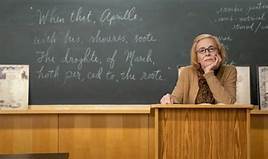 One of the “ancients” on the faculty of the English Dept.
One of the “ancients” on the faculty of the English Dept.First, the dean tells Chairwoman Kim that budget decreases are coming and she needs to make some cuts in her department, preferably convincing a few of the ancient faculty members to retire. (In academia, there is no established retirement age. Professors can conceivably rule the classroom until they drop).
Then, one of her senior professors is on the warpath because she has been moved to a dingy basement office in another building in order to accommodate the department’s newest hire. (God help any department chair or head who has to deal with THAT issue. And I speak from experience! Next to tenure, having prime office space is the most critical item on any professor’s agenda).
Chairwoman Kim discovers that the newest hire, a hip African-American woman named Yaz McKay, is a self-absorbed narcissist who will demand “special handling.”
 Chairwoman Kim on the campus of Pembroke U.
Chairwoman Kim on the campus of Pembroke U.Why? Because she has been assigned to team-teach an American literature survey course with stubborn old-school octogenarian Professor Elliot Rentz, whose classes students shun because they are uninspiring and mind-numbing.
Professor McKay is not happy about her teaching assignment, but she is an assistant or associate professor (it wasn’t clear which) on the tenure track and Rentz is the chair of her tenure committee—which gives him extraordinary leverage over her.
Rentz is a dull, inflexible traditionalist and that’s how he approaches his poorly attended classes. Professor McKay is his “woke” polar opposite, and it doesn’t take her long to demonstrate that fact.
To Rentz’s horror, Professor McKay decides to teach Herman Melville’s classic 19th Century book “Moby Dick” using a bevy of student rappers. In a jaw-dropping classroom performance, the rapping students turn Melville’s classic prose into an effervescent hip-hop chant. Professor Rentz is outraged by such literary impertinence.
While Professor McKay’s idea is hip and trendy, in the end, it simply panders to the students’ “wokeness” and fails to engage them intellectually. Eventually, Professor McKay feels undermined by Professor Rentz and threatens to leave Pembroke for Yale, where she has been offered both tenure and an endowed chair.
To top things off, Bill Dobson, one of Pembroke’s most popular literature professors, who is also a nationally recognized author, is caught on camera joking around in class wearing a Nazi SS uniform and giving the “Heil Hitler” salute.
Pembroke’s ultra-woke liberal students are not amused. In fact, they are outraged and demand that Professor Dobson be fired from his tenured position. Never mind that the besieged Professor Dobson was simply attempting to demonstrate the farcical connection between fascism and the absurd.
The Dean of the college caves and Dobson is dragged before a disciplinary committee where he is suspended.
And all of this is only a few weeks into Professor Kim’s tenure as department chair.
I found myself thinking: “God help her. She has just entered the malevolent academic dominion known as “administration hell.”
At this point, it might be well to mention the oft-repeated axiom that says: “Academic politics are so vicious precisely because the stakes are so small.”
Some attribute that axiom to former Secretary of State Henry Kissinger, but others say it was first uttered by Wallace S. Sayre, a late Professor of Political Science at Columbia University.
No matter. The fact is that in Academia the intensity of feeling in any dispute is inversely proportional to the value of the stakes at issue—and that is why academic politics are so bitter.
So is the Chair an accurate portrayal of academe? The Chair has its authentic moments.
For example, its portrayal of the English department’s eclectic group of faculty, their attitudes, and their unremitting grievances, is on point.
So too are the rigid and some might say unconstitutional rules that govern behavior in the academy. They are accurately depicted. For example, poor Professor Dobson is granted only minimal due process before he is tossed onto the academic scrap heap. In the academy, you are always guilty until proven innocent–all rights guaranteed by the Consitution notwithstanding.
But where The Chair really hits its stride (whether intentionally or not) is its portrayal of today’s woke and hypersensitive students.

Pembroke University students seem more intent on preserving their malicious and intolerant mob mentality than in engaging in any kind of evocative debate that might require them to open their minds to new or diverse ideas.
The horde of vociferous brats screaming for the head of Professor Dobson and who eventually cause Chairwoman Kim to lose her position as department chair, are self-absorbed holy terrors seemingly bent on Pembroke’s destruction rather than acquiring a comprehensive education.
In their minds, Pembroke is too orthodox, too straight, and too white. It also tolerates too much conservative thought that conflicts with the students’ deeply entrenched liberal dogma and to many students, that is “threatening.”
In that respect “The Chair” has gotten it right. Universities should not be spineless places replete with “safe spaces” or wokeness zones.
They should be places where learning is rigorous, where students are exposed to a broad array of attitudes, philosophies, and viewpoints—no matter how unpleasant and objectionable they may seem to today’s squeamish brood of fragile progeny.
There is an old African proverb that says: “Smooth seas do not make skillful sailors.”
Should there be a season two of “The Chair,” the doyens at Pembroke would do well to heed that aphorism and restore Professors Kim and Dobson to their previous positions.
I know I would if I were the dean.
September 14, 2021
All Authors Should be Appalled by This!
I posted this commentary a couple of years ago. Since then, nothing has changed. Laura Ingalls Wilder’s Little House on the Prairie books are still banned in many schools today and Laura Ingalls Wilder’s name is still excised from the award once named in her honor. This is censorship in action. All authors should be appalled and the Association of Library Service to Children should be ashamed. To learn more about this literary suppression and bowdlerization, please read on.
In yet another example of twenty-first-century political correctness invading and perverting the past, the Association of Library Service to Children voted unanimously recently to remove Laura Ingalls Wilder’s name from the Laura Ingalls Wilder Award and instead call it the Children’s Literature Legacy Award.
Why, might you ask, would the ALSC, a division of the American Library Association do something like this to such a beloved author as Wilder? Because of her portrayal of minorities and Native Americans in her “Little House on the Prairie” novels, the ALSC says.
Nevermind that Wilder was the first to win the award in 1954 when she was in her late 80s and nearing the end of her life. Until her death in 1957 she was beloved for the semiautobiographical “Little House” children’s books, which are fictionalized versions of her family’s adventures traveling the western frontier in their covered wagon and its encounters with Native Americans.
“This decision was made in consideration of the fact that Wilder’s legacy, as represented by her body of work, includes expressions of stereotypical attitudes inconsistent with ALSC’s core values of inclusiveness, integrity, and respect, and responsiveness,” the Association for Library Service to Children said in a statement.
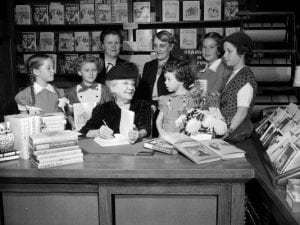 Laura Ingalls Wilder at a 1930s book signing
Laura Ingalls Wilder at a 1930s book signingIn its decision to remove Wilder’s name from the award, the library association cited “anti-Native and anti-Black sentiments in her work.”
What a bunch of hooey.
The reason is quite simply this: The ALSC has decided to apply 21st-century attitudes about race and minorities to literature that accurately portrays those attitudes as they existed in the 19th century.
Authors of historical fiction should be outraged by this kind of gratuitous censorship and suppression. I know I am.
While passages within Wilder’s work reflect many attitudes of the era, the section of literature most often cited in this debate is from the 1935 story “Going West,” about a pioneering family.
In the book, the character “Pa” explains that on the land his family is seeking, “there were no people. Only Indians lived there.”
In 1953, Wilder changed the passage to say, “there were no settlers there. Only Indians lived there.”
That change has not appeased the politically correct crowd, however. Never mind the fact that in her books Wilder correctly portrayed the pioneer environment in which she grew up. That apparently offends people who say she should have been “more inclusive” in her books and provided more examples of “diversity.”
Once again, what a bunch of hooey.
I belong to a lively Historical Novels online discussion group in which authors engage in discussions ranging from how one researches historical novels to selecting book titles. Most recently someone started a discussion about whether or not we authors should be politically correct when writing historical fiction. The result was a long thread of comments from authors of historical fiction.
Almost to a person, authors of historical novels say political correctness should NEVER influence how we write about the past. To do so is to be disingenuous to those who read our books.
Our job as authors of historical fiction is NOT to “clean up” or rewrite history, so the sins of the past are expunged from our consciousness. The fact is, overt racism, religious oppression, and other forms of discrimination have been part of life for several thousand years. They still are.
You can see how political correctness has distorted the literary landscape when writers of historical fiction attempt to cleanse offensive language in their books that once was used to describe certain races, classes, religions, and ethnic groups.
As one group member said: “Let’s not only get political correctness out of historical fiction, let’s get it out of society. If you wrote a Civil War story and had a character refer to a black person as an African-American, you ought to be horsewhipped.”
Let me say it forthrightly and plainly: political correctness has no place in historical fiction or, for that matter, in any other form of literature. If you are striving to create accurate characters and events in a novel about the past, you must create characters that think, speak, and act the way they did during the period in which the story is set. You cannot impose inclusiveness and diversity retroactively by substituting today’s anodyne language for the often provocative and offensive vernacular of the past.
To inflict today’s political correctness on literary art is to censor and suppress creativity. PC has already overrun and dampened free speech and innovative thought in our schools and on college campuses. God forbid that the thought police should be successful in invading the province of historical fiction too!
The PC thought police have been successful in getting American classics like Huckleberry Finn and Tom Sawyer by Mark Twain and Uncle Tom’s Cabin by Harriet Beecher Stowe removed from some school libraries because of their use of language and racial characterizations prevalent in 19th Century America. They have even convinced a few publishers to issue “cleansed” versions of Mark Twain’s work with some passages and descriptions rewritten and some offensive words removed.
That is nothing more than the desecration of art. As writers of historical fiction, it is incumbent upon us to be truthful in our depictions of times past–ugly warts and all.
For the PC thought police, it is not only the politically incorrect word or name that is the problem. It’s a person’s attitude, an individual’s mindset, his or her ability to think freely and express himself or herself in a particular way that the PC bullies want to control. If an individual’s opinions do not conform to their Weltanschauung, then those views should not be expressed. This is intolerance in the extreme.
The underlying question is this: are we really ‘free’ in what we choose to write and say? Do we indeed still have ‘freedom of speech’ as guaranteed by the First Amendment, or do we now SELF-CENSOR because we are afraid of ‘the backlash’?
For those who write or who create other forms of art, these are critical questions that need to be considered. I for one will not be bullied by the PC thought police in my historical novels. I want my work to accurately reflect the time in which my novels are set.
Politically correct speech and its offshoots of intolerance, censorship, and social intimidation are the greatest dangers to free speech since the First Amendment was inserted into our Constitution in 1791. If the PC thought police manage to eviscerate that critical component of our Constitution, freedom of speech will cease to exist.
Laura Ingalls Wilder does not deserve this kind of bowdlerization and maleficent treatment by the Association for Library Service to Children and its parent, the American Library Association.
Authors of historical novels should be sickened and disgusted by this treatment of one of America’s most treasured authors.
In the meantime, the Children’s Literature Legacy Award will remain a fraud because by cleansing the muck and ignominy from our collective history we are being dishonest and insincere with the children we are charged with educating.

